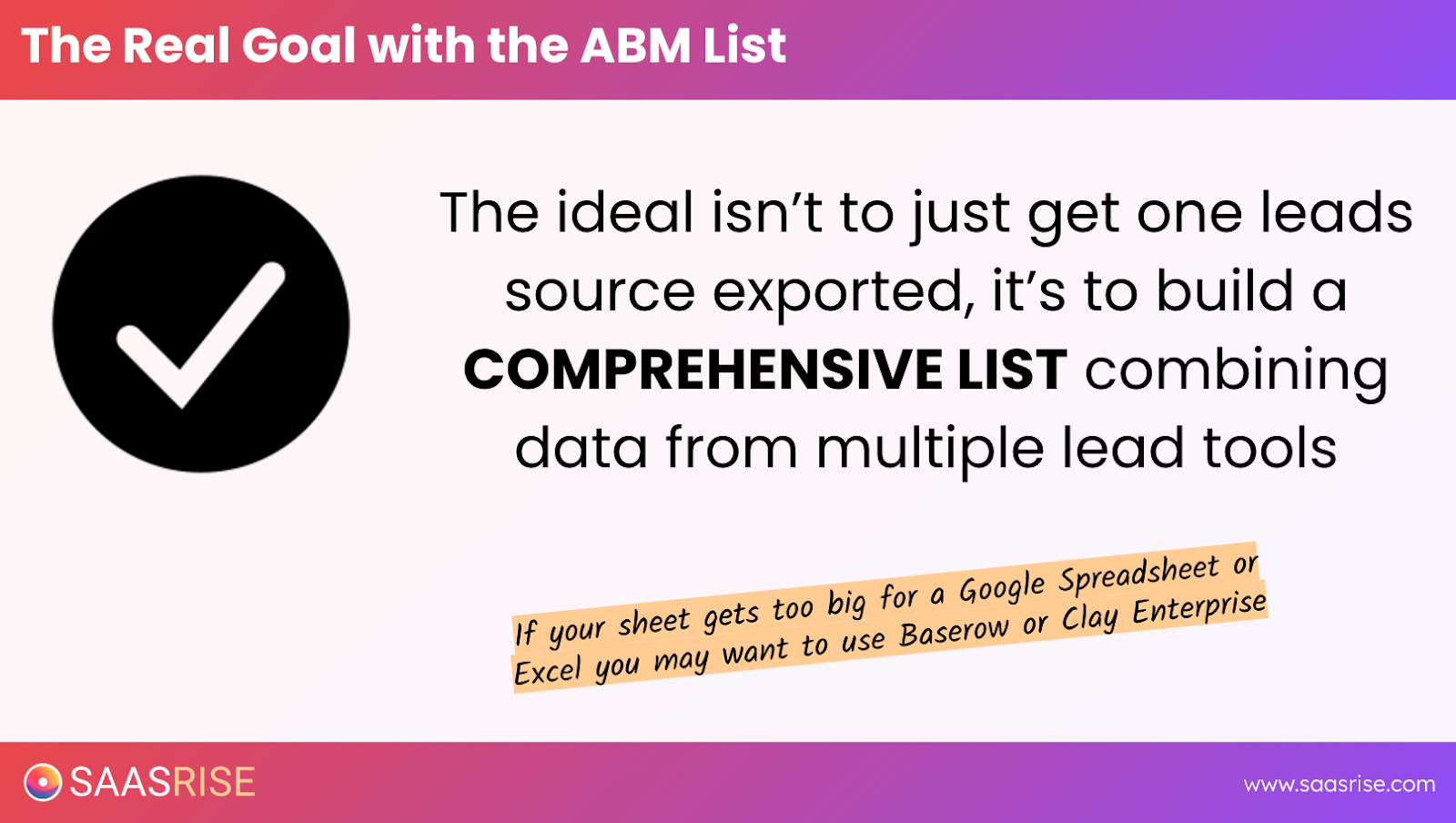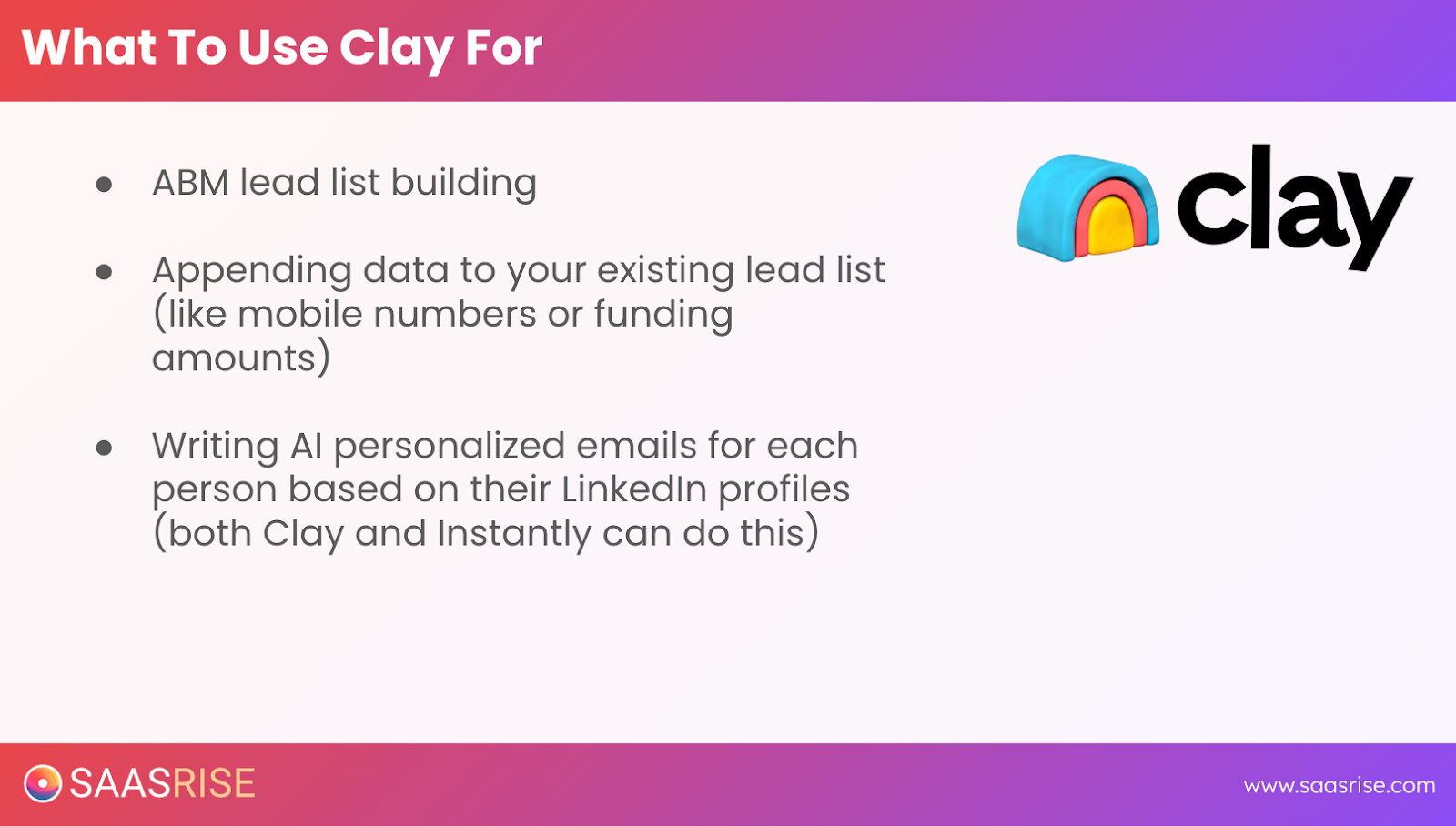
How to Use LinkedIn Sales Navigator and Clay to Build a Winning ABM Lead List
You can have the best product in your category, but if you’re marketing to the wrong people — or worse, guessing who your ideal buyer is — you’ll waste time, budget, and momentum.
If you’re running a B2B SaaS company, there’s one thing that can make or break your growth: your audience. That’s where Account-Based Marketing (ABM) changes the game.
The secret to effective ABM isn’t magic or luck. It’s data — building precise, high-quality lists of the people who actually buy what you sell. And when it comes to building those lists, few tools are more powerful than LinkedIn Sales Navigator and Clay. This is the playbook for using both tools together to build, clean, and enrich your ABM lead list — and to turn that list into the foundation of scalable, predictable growth.
This content is from the 16 week B2B SaaS Growth Program that we run twice a year.


Why ABM Still Works in B2B SaaS
B2B growth doesn’t come from shouting louder — it comes from being more precise. The goal isn’t to reach everyone. It’s to reach everyone who matters.
If you sell to marketing leaders at mid-sized tech companies, you don’t need a million impressions — you need a few thousand right people seeing your brand consistently until they trust you.
ABM is built for this. It’s about knowing your total addressable market (TAM), identifying the key people inside those companies, and reaching them through multiple channels — email, LinkedIn, ads, and content — until your company becomes top of mind in their space.
But you can’t do great ABM without great data. And that’s why building a clean, verified, and enriched lead list is the first real step to scaling your SaaS growth engine.

The Foundation: From Random Prospecting to Precise Targeting
Before we get into tools, let’s get the fundamentals right.
You should already have your unit economics dialed in — things like your CAC, LTV, and payback period — and a clear definition of your Ideal Client Profile (ICP).
Once you know who you want to reach, the next step is to build a complete and verified list of those people. Most founders start this process with tools like Apollo or Instantly, which are great for getting volume fast.
But the real quality data — the kind that lets you do personalized outreach and run high-performing ad campaigns — comes from platforms like LinkedIn Sales Navigator and Clay. These two tools work beautifully together. LinkedIn gives you accuracy and recency; Clay gives you enrichment, automation, and scale.
Let’s break down how to use both.
Why LinkedIn Sales Navigator Is Still the Best Source of Real-Time B2B Data
Think about it — LinkedIn is the single most up-to-date professional database in the world.
When someone changes jobs, gets promoted, or switches industries, the first thing they update is their LinkedIn profile. That makes it one of the most accurate and current data sources you can find for B2B prospecting.
The challenge? It’s not built for easy exporting or high-volume data extraction.
But with the right setup, you can get exactly what you need.
How to Build a Lead List with LinkedIn Sales Navigator
- Run a focused search.
Start by filtering for job titles, industries, company sizes, and locations that match your ICP. For example: “CEOs and Founders at software companies with 11–1,000 employees in North America.” - Exclude irrelevant roles.
Filter out assistants, consultants, students, or unrelated titles so you’re not paying for useless data. - Export your list using Chrome extensions.
LinkedIn doesn’t allow CSV downloads directly. Tools like Evaboot, FindEmail, and Wiza help you export up to 2,500 contacts at a time. - Split your searches into smaller batches.
LinkedIn caps search visibility at 2,500 results (100 pages × 25 records). To go beyond that, run multiple searches by state, company size, or job title to cover your market in full. - Verify every email before outreach.
Once exported, run your list through a verifier like ZeroBounce, MillionVerifier, or Bulk Email Checker. Keeping bounce rates under 2% protects your sender reputation and ensures deliverability.
Yes, it’s tedious. But the payoff is huge — LinkedIn data is clean, current, and specific to your audience.
How to Use Clay to Enrich and Scale Your ABM List
Once you’ve got a base list, it’s time to enhance it — verify the data, fill in missing information, and prep it for outbound and ads.
That’s where Clay shines.
Clay is an all-in-one data enrichment and automation tool that can turn a simple spreadsheet of names into a rich database of insights.
What Clay Does for You
- Builds new lead lists based on your ICP
- Enriches existing lists with verified work emails, phone numbers, LinkedIn URLs, and company data
- Runs AI-based personalization for cold outreach
- Integrates directly with outbound and ad platforms
In other words, Clay transforms static spreadsheets into dynamic, high-value sales assets.

How to Build and Enrich an ABM List in Clay
- Find people or companies.
You can start from scratch or upload an existing list from Apollo, LinkedIn, or any other source. - Apply filters for precision.
Set parameters for job titles, industries, company size, and geography. You can even exclude specific companies or domains you already have. - Add enrichment layers.
Clay integrates with multiple data providers (like LeadMagic, FindEmail, and DropContact) and uses a waterfall enrichment process — it pulls from several sources to find verified work emails, personal emails, and phone numbers. - Bring in LinkedIn data.
With one click, Clay can fetch a contact’s full LinkedIn profile — including their headline, experience, education, and summary. This becomes gold when you’re doing AI personalization later. - Use AI for personalization.
Plug in OpenAI, Claude, or Gemini’s API to automatically generate custom intros and PS lines for every contact. One good prompt can write thousands of personalized emails in seconds. - Export and integrate.
Once enriched, you can export your list as a CSV or connect it directly to your outbound tool (like Instantly or Smartlead) for immediate campaign use.
This is where your ABM list becomes a living system — continuously enriched, verified, and ready for action.
How to Combine LinkedIn Sales Navigator and Clay
The real magic happens when you connect both tools into a single workflow.
Here’s how they fit together:

This workflow ensures that your ABM data stays current, complete, and connected across every marketing channel.
How Big Should Your ABM List Be?
It depends entirely on your ACV (Annual Contract Value).
Here’s a simple guide:

Low-ACV products need scale to make the math work. High-ACV offerings can go deep with fewer, higher-quality prospects.
What to Do Once You Have Your List
Building the list is just step one. Here’s what to do next:
- Launch AI-personalized outbound campaigns.
Use the enriched data to create highly relevant, personalized emails. Expect 2–3x more engagement compared to generic messages. - Run matched-audience ads.
Upload your ABM list to LinkedIn, Meta, and Google Ads. Use a tool like Primer to improve match rates and keep audiences synced automatically. - Create weekly content for nurture.
Publish and distribute one strong piece of content per week (video, case study, or email) that educates your audience and keeps your brand top of mind. - Feed engagement back into your CRM.
Sync your list with your CRM and use lead scoring to identify which prospects are most engaged and ready for SDR follow-up.
Common Mistakes to Avoid
Here’s what can trip you up when building your ABM lists:
❌ Buying random email lists.
Never buy from unknown sources. Unverified contacts will ruin your sender reputation.
❌ Skipping verification.
Always verify before sending. Even good data decays fast.
❌ Over-segmentation.
It’s tempting to create 20 different micro-lists — but simplicity scales faster. Start broad, then refine.
✅ Do this instead:
- Verify and clean your lists every few months.
- Combine outbound + ads for omnipresence.
- Use personalization where it moves the needle, not everywhere.
Final Thoughts
ABM list building isn’t just a marketing exercise — it’s the backbone of scalable growth.
When you have a verified, enriched, and organized list of every decision-maker in your market, everything else gets easier:
- Your ads convert better.
- Your outbound hits harder.
- Your sales cycle gets shorter.
LinkedIn gives you the data. Clay gives you the enrichment and automation. Together, they help you build a predictable, repeatable system that fills your pipeline month after month.
Start building your list the right way — precise, data-driven, and human at the same time.
That’s how you scale SaaS without burning through your marketing budget.
This content is from the 16 week B2B SaaS Growth Program that we run twice a year.

